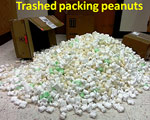Making Batteries from Packing Peanuts
 Mar-24-15
By subjecting the common packing peanut to extreme temperatures, researchers have found a way to reuse the ubiquitous material in lithium-ion batteries.
Mar-24-15
By subjecting the common packing peanut to extreme temperatures, researchers have found a way to reuse the ubiquitous material in lithium-ion batteries.The technique was developed by a team a Purdue University in Indiana, who were inspired to find a way to use the packing peanuts that had recently arrived with a shipment of new lab equipment. In what is described as a "simple and straightforward approach," the team heated the peanuts to between 932 and 1652ºF to create graphite sheets for use as anodes. This was carried out in a furnace with an inert atmosphere and, depending upon the material and procedure used, either in the presence or absence of a transition salt catalyst.
The result was thin, microsheets of carbon with a crystal structure able to contain lithium ions more efficiently during the charging and discharging process. This increased efficiency in due in part to the size of the peanut-based anodes, which are one tenth the thickness of conventional anodes.
More Info about this Invention:
[POPSCI.COM][PURDUE.EDU]

Add Your Comment